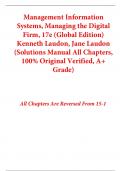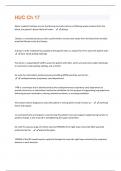Management Information
Systems, Managing the Digital
Firm, 17e (Global Edition)
Kenneth Laudon, Jane Laudon
(Solutions Manual All Chapters,
100% Original Verified, A+
Grade)
All Chapters Are Reversed From 15-1
, Chapter 15
Managing Global Systems
Student Learning Objectives
15-1 What major factors are driving the internationalization of business?
15-2 What are the alternative strategies for developing global businesses?
15-3 What are the challenges posed by global information systems and management
solutions for these challenges?
15-4 What are the issues and technical alternatives to be considered when developing
international information systems?
15-5 How will MIS help my career?
Key Terms
The following alphabetical list identifies the key terms discussed in this chapter. The
page number for each key term is provided.
Business driver, 594 Legitimacy, 606
Cooptation, 607 Multinational, 601
Core systems, 604 Particularism, 598
Domestic exporter, 600 Software localization, 611
Franchisers, 601 Transborder data flow, 599
Global culture, 595 Transnational, 601
International information systems
architecture, 594
Teaching Suggestions
The Bel Group: Laughing All the Way to Success
The opening case, “The Bel Group: Laughing All the Way to Success,” identifies some of
the issues that organizations need to consider if they want to operate worldwide. Like
many large, multinational firms, Bel has subsidiaries and sales offices in a number of
different countries. It also has an acquisition strategy that means potential differences in
systems, business processes, and reporting standards have to be managed. Given the
Group’s product range and target audience, creating a customer bond and building
customer understanding is vital to success. In a mobile-enhanced world, communication
speed and customization across diverse contact points becomes a requirement. The
company identified the need for a scalable, easy-to-use system that would provide an
15-1
Copyright © 2022 Pearson Education Ltd.
,effective measurement tool for different marketing campaigns in order to meet the
varying needs of its target audiences.
Section 15-1, “What major factors are driving the internationalization of business?”
Figure 15-1 is an excellent example of the globalization of businesses and industries. This
figure shows how one product, the Apple iPhone, involves operations in seven different
countries around the world. That is possible only through advanced networks and
information systems like the one Apple uses. Students might find it interesting to trace
common products through the design, production, and distribution phases to see the
globalization of industries first-hand. They can use the Internet to research this
information for themselves.
This section discusses the added challenges corporations face when they do business on a
global scale. Cultural particularism, social expectations, and political laws that vary from
country to country add layers to business processes, management strategies, and
information requirements that are not present in domestic companies. The problems and
situations in this section are the basis for the remaining sections—how to organize and
manage information systems that meet these challenges and serve a business worldwide.
Section 15-2, “What are the alternative strategies for developing global businesses?” It
is important for students to understand that a company’s corporate headquarters isn’t
always located in the United States as many people assume. There are many instances of
companies whose corporate headquarters are located in foreign countries and simply have
local or regional operations in the United States. This section defines four business
strategies and structures global companies can use: domestic exporter, multinational,
franchiser, transnational. It is an interesting exercise for students to classify companies
tthey are familiar with into one of these four categories. For instance, Caterpillar is a
domestic exporter, Intel is a multinational, McDonald’s is a franchiser, and Sony is a
transnational. The section ends by matching the appropriate system configuration with
the global strategy that a company uses.
Section 15-3, “What are the challenges posed by global information systems and
management solutions for these challenges?” Take all the problems and challenges that
a domestic company faces in designing, building, and managing its information
technology infrastructure and magnify them on a global scale. The subsection “A Typical
Scenario: Disorganization on a Global Scale” describes the more common situation
occurring in global corporations—a hodgepodge of hardware, software, and
telecommunications. The section describes how to arrive at a solution to these problems
by defining core business processes, choosing an approach, and making the benefits clear
to users. Using Table 15-4, you can demonstrate management challenges and solutions to
creating a global information technology infrastructure.
Section 15-4, “What are the issues and technical alternatives to be considered when
developing international information systems?” Students may assume that all countries
have the same technology and telecommunications infrastructure as the United States.
Many students are also under the impression that the United States leads the world in
15-2
Copyright © 2022 Pearson Education Ltd.
, technology usage and advanced applications. Spend some time discussing how both
assumptions are untrue. The disparate levels of telecommunications services throughout
the world add to the challenges and difficulties of developing global information systems.
It may also be interesting to discuss the challenges in developing software for global
systems because of language and cultural differences. For instance, when a company
develops a user interface for applications that will supposedly be used worldwide, should
the English language be used, or should the application be adaptable to local languages
via software localization? Discuss the challenges in using two different languages for
similar applications.
Interactive Session: Management: Rethinking Global Supply Chains
Case Study Questions
1. What factors have contributed to the growth of global supply chains?
Lower transportation costs, falling trade barriers, the growth of subcontracting, and
use of the Internet as a low-cost global communication tool have enabled many
companies to shift to a global sourcing model.
2. What are the advantages and disadvantages of global supply chains?
Global supply chains have made it possible for original equipment manufacturers
(OEMs) and Tier 1 vendors in the various industry supply chains, for example, to
meet aggressive cost targets while keeping the price of new products low.
The complexity of having many levels of tiers for supply lines makes it very difficult
for companies to have visibility into who their suppliers actually are. Without this
knowledge, many companies are caught off guard when major disruptions occur.
3. What measures can companies take to mitigate supply chain risk?
Businesses should eliminate their dependence on sourcing from a single supplier,
region, or country. They should develop alternate supply sources and increase their
safety stocks. These moves will increase costs, but they will make supply chains more
resilient. Companies should also consider more regionalization of production and
even localization
of suppliers if feasible. Lastly, companies should consider reducing the number of
products they make.
4. Should companies continue to maintain global supply chains? Explain your
answer.
Companies should continue to maintain global supply chains as the pros outweigh the
cons for the business. What is important is to recognize some of the steps and ways
that problems and issues can be mitigated so that the impacts are less severe when
something unexpected might interrupt the supply chain.
15-3
Copyright © 2022 Pearson Education Ltd.





